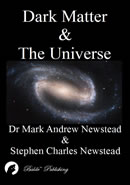
|
Dark Matter & The Universe
First Edition, Hardback Book, Published in 2010,
169 Pages,
20 Figures,
1 Table,
Suitable for Academics and Researchers,
Authors:
Dr Mark Andrew Newstead
Stephen Charles Newstead
Download the Book (6.50Mb)
(If you get an error when opening the book, try re-downloading) |
Abstract
Predictions
Explanations
Abstract: The work in this book follows on from the previous two books, The Atom Uncovered and Gravity & Electromagnetic Waves and is fully consistent with them. T
o start with, in this book we show that dark matter does consists of baryons, as well as why scientists have either dismissed their presence or not been able to detect them.
We then go on to propose a slightly different qualitative model to that of the Big Bang. This model proposes that the whole
universe is actually cyclic in nature, which moves between being matter, antimatter and energy dominated. We also show how the model deals with the expansion of the universe, the large
scale homogeneity, the cosmic microwave background radiation and its fluctuations, the time dilation of supernova brightness curves, the Tolman test plus other observations and tests. Furthermore,
the model is able to explain how the different types of galaxies and their sub-classes within the universe are produced. In fact the production of the different types of galaxies is all consistently
dealt with, in how the universe develops and grows over time. Lastly, it is able to give answers to why the universe appears flat and has a horizon, plus why there is a matter, antimatter asymmetry.
Top
Predictions:
- Dark matter particles are actually neutrons.
- In particular these dark matter neutrons are stable (or have a very long half life), since they are able rotate and thus emit radiation, which scientists call the cosmic microwave background radiation.
- The shape of the universe is closed, i.e. a hyper-sphere.
- Hence there exists a horizon to the universe, similar to the horizon on Earth.
- This horizon is at least 13.7 billion light years away.
- Initially the universe was full of only energy (i.e. no matter existed).
- Also supermassive black holes where the first objects created.
- These supermassive black holes emit neutrons in a planer fashion and it is these holes that produce all the matter within the universe.
- The wavelength of electromagnetic waves linearly increases as they travel through space and thus their frequency and energy continuously decreases.
- There should be more gravity now than in the past.
- The universe is cyclic at all levels, e.g. the whole universe, galactic clusters, ...
- When two spiral or bar galaxies collide, they form an elliptical galaxy.
- Also objects are generally closer to us than is currently estimated.
- How the different types of galaxies are formed.
- Supermassive black holes continuously decrease the background energy of the universe, which would appear as a temperature drop.
Top
Explanations:
- How the universe converted from something that was (or mainly) energy based, to the matter dominated universe we have today.
- How supermassive black holes are created.
- Why supermassive black holes exist at the centre of all major galaxies.
- Why there is a link between the mass of the supermassive black hole and the size of its surrounding galaxy.
- How the web like structure of galaxies was formed.
- Why the background temperature of the universe is constant in all directions.
- Why we do not observe any population III stars.
- Why mature elliptical galaxies only contain old stars.
- Why elliptical galaxies have high star production initially before it stops for the rest of the galaxies life.
- Why the vast majority of dwarf galaxies are found within the dark matter halo of major galaxies.
- The apparent expansion of the universe and Hubble’s relationship.
- Why time is affected by distance, for example why a supernova explosion appears to happen over a longer period of time, the further away from us it is.
- Why the universe appears homogeneous on very large scales.
- Why the observable universe is dominated by matter, as opposed to anti-matter.
- Why there is an abundance of light elements in the “early” universe.
- The cosmic microwave background radiation and its fluctuations.
- How jets are formed from active galactic nuclei.
- How the temperature of a blackbody radiation curve would decrease with distance and the Tolman test.
- How and why brightness and intensity change with distance.
- Why the Sunyaev-Zel’dovich and integrated Sachs-Wolfe effect are observed.
- What dark energy and dark flow is.
Top
|

